Source Apportionment of Chemical Elements and Their Geochemical Baseline Values in Surface Water of the Parauapebas River Basin, Southeast Amazon, Brazil
Abstract
:1. Introduction
2. Materials and Methods
2.1. Characteristics of the Study Area
2.2. Hydrography, Vegetation and Climate
2.3. Geological Setting of the Region
2.4. Sampling
2.5. Water Quality Parameters and Analytical Techniques
3. Results
3.1. Basic Characteristics
3.2. Descriptive Statistics
3.2.1. Physico-Chemical Parameters
3.2.2. Major and Trace Elements
3.3. Spatial Distribution
3.3.1. Physico-Chemical Parameters
3.3.2. Major Ions
3.3.3. Trace Elements
3.4. Multivariate Statistics
3.5. Geochemical Baseline Estimation of Metals in Surface Water of the Parauapebas River Basin
4. Discussion
4.1. Influence of Seasonal Variations on the Geochemistry of Surface Water
4.2. Influence of Lithology vs. Anthropic Effects on Water Geochemistry
4.3. Influence of Land Use and Coverage on Water Geochemistry
4.4. Geochemical Baseline Values for Metals in the Parauapebas River Basin
5. Conclusions
Supplementary Materials
Author Contributions
Funding
Data Availability Statement
Acknowledgments
Conflicts of Interest
References
- Hem, J.D. Study and Interpretation of The Chemical Characteristics of Natural Water, 3rd ed.; US Geological Survey Water-Supply: Alexandria, VA, USA, 1985; Paper No. 2254. [Google Scholar]
- Sahoo, P.K.; Dall’Agnol, R.; Salomão, G.N.; da Silva Ferreira Junior, J.; Silva, M.S.; e Souza Filho, P.W.M.; Powell, M.A.; Angélica, R.S.; Pontes, P.R.; da Costa, M.F.; et al. High Resolution Hydrogeochemical Survey and Estimation of Baseline Concentrations of Trace Elements in Surface Water of the Itacaiúnas River Basin, Southeastern Amazonia: Implication for Environmental Studies. J. Geochem. Explor. 2019, 205, 106321. [Google Scholar] [CrossRef]
- Salomão, G.; Dall’Agnol, R.; Sahoo, P.; Ferreira, J., Jr.; Silva, M.; Souza-Filho, P.; Berrêdo, J.F.; Nascimento, W., Jr.; Costa, M. Geochemical Distribution and Threshold Values Determination of Heavy Metals in Stream Water in the Sub-Basins of Vermelho and Sororó Rivers, Itacaiúnas River Watershed, Eastern Amazon, Brazil. Geochim. Bras. 2018, 32, 180–198. [Google Scholar] [CrossRef]
- Gómez, R.; Arce, M.I.; Baldwin, D.S.; Dahm, C.N. Water Physicochemistry in Intermittent Rivers and Ephemeral Streams; Academic Press: Cambridge, MA, USA, 2017; pp. 109–134. [Google Scholar] [CrossRef]
- Boyer, E.W.; Hornberger, G.M.; Bencala, K.E.; McKnight, D.M. Response characteristics of DOC flushing in an alpine catchment. Hydrol. Processes 1997, 11, 1635–1647. [Google Scholar] [CrossRef]
- Kump, L.R.; Brantley, S.L.; Arthur, M.A. Chemical weathering, atmospheric CO2, and climate. Annu. Rev. Earth Planet Sci. 2000, 28, 611–667. [Google Scholar] [CrossRef] [Green Version]
- Bundschuh, J.; Prakash, J.; Mushtaq, S.; Vithanage, M.; Guilherme, L.R.G.; Reardon-Smith, K.; Parvez, F.; Morales-Simfors, N.; Ghaze, S.; Pudmenzky, C.; et al. Medical Geology in the Framework of the Sustainable Development Goals. Sci. Total Environ. 2016, 581, 87–104. [Google Scholar] [CrossRef] [PubMed]
- Silveira, M.P. Aplicação do Biomonitoramento Para Avaliação da Qualidade da Água em Rios; Embrapa Meio Ambiente: Jaguariúna, Brazil, 2004; p. 68. [Google Scholar]
- Khatri, N.; Tyagi, S. Influences of natural and anthropogenic factors on surface and groundwater quality in rural and urban areas. Front. Life Sci. 2014, 8, 23–39. [Google Scholar] [CrossRef]
- Matschullat, J.; Ottenstein, R.; Reimann, C. Geochemical Background—Can We Calculate It? Environ. Geol. 2000, 39, 990–1000. [Google Scholar] [CrossRef]
- Reimann, C.; Garrett, R.G. Geochemical Background—Concept and Reality. Sci. Total Environ. 2005, 350, 12–27. [Google Scholar] [CrossRef] [PubMed]
- Urresti-Estala, B.; Carrasco-Cantos, F.; Vadillo-Pérez, I.; Jiménez-Gavilán, P. Determination of Background Levels on Water Quality of Groundwater Bodies: A Methodological Proposal Applied to a Mediterranean River Basin (Guadalhorce River, Málaga, Southern Spain). J. Environ. Manag. 2013, 117, 121–130. [Google Scholar] [CrossRef]
- Galuszka, A. Different approaches in using and understanding the term “Geochemical Background”—Pratical implications for environmental studies. Pol. J. Environ. Stud. 2007, 16, 389–395. [Google Scholar]
- Galuszka, A. A Review of Geochemical Background Concepts and an Example Using Data from Poland. Environ. Geol. 2007, 52, 861–870. [Google Scholar] [CrossRef]
- Tidball, R.R.; Erdman, J.A.; Ebens, R.J. Geochemical baselines for sagebrush and soil, Powder River Basin, Montana Wyoming. United States Geol. Surv. OpenFile Rep. 1974, 74, 6–13. [Google Scholar]
- Nriagu, J.O. A global assessment of natural sources of atmospheric trace metals. Nature 1989, 338, 47–49. [Google Scholar] [CrossRef]
- Arpine, H.; Gayane, S. Determination of Background Concentrations of Hydrochemical Parameters and Water Quality Assessment in the Akhuryan River Basin (Armenia). Phys. Chem. Earth 2016, 94, 2–9. [Google Scholar] [CrossRef]
- Wendland, F.; Berthold, G.; Blum, A.; Elsass, P.; Fritsche, J.-G.; Kunkel, R.; Wolter, R. Derivation of natural background levels and threshold values for groundwater bodies in the Upper Rhine Valley (France, Switzerland and Germany). Desalination 2008, 226, 160–168. [Google Scholar] [CrossRef]
- Jardim, C.H. A “Crise Hídrica” No Sudeste do Brasil: Aspectos Climáticos e Repercussões Ambientais. Rev. Tamoios 2015, 11, 67–83. [Google Scholar] [CrossRef] [Green Version]
- Martirani, L.A.; Peres, I.K. Water crisis in São Paulo: News coverage, public perception and the right to information. Ambiente E Soc. 2016, 19, 1–20. [Google Scholar] [CrossRef]
- Nobre, C.; Marengo, J.; Seluchi, M.; Cuartas, L.; Alves, L. Some Characteristics and Impacts of the Drought and Water Crisis in Southeastern Brazil during 2014 and 2015. J. Water Resour. Prot. 2016, 8, 252–262. [Google Scholar] [CrossRef] [Green Version]
- Vasconcelos, C.H.; Andrade, R.C.d.; Bonfim, C.V.; Resende, R.M.d.S.; Queiroz, F.B.d.; Daniel, M.H.B.; Grigoletto, J.C.; Cabral, A.R.; Redivo, A.L.; Lacerda, J.C.V.; et al. Surveillance of the Drinking Water Quality Din the Legal Amazon: Analysis of Vulnerable Areas. Cad. Saúde Coletiva 2016, 24, 14–20. [Google Scholar] [CrossRef] [Green Version]
- Souza-Filho, P.W.M.; de Souza, E.B.; Silva, R.O., Jr.; Nascimento, W.R.; Versiani de Mendonça, B.R.; Guimarães, J.T.F.; Dall’Agnol, R.; Siqueira, J.O. Four Decades of Land-Cover, Land-Use and Hydroclimatology Changes in the Itacaiúnas River Watershed, Southeastern Amazon. J. Environ. Manag. 2016, 167, 175–184. [Google Scholar] [CrossRef]
- Martinelli, L.A.; Naylor, R.; Vitousek, P.M.; Moutinho, P. Agriculture in Brazil: Impacts, Costs, and Opportunities for a Sustainable Future. Curr. Opin. Environ. Sustain. 2010, 2, 431–438. [Google Scholar] [CrossRef]
- Lima, L.S.; Coe, M.T.; Soares Filho, B.S.; Cuadra, S.V.; Dias, L.C.P.; Costa, M.H.; Lima, L.S.; Rodrigues, H.O. Feedbacks between Deforestation, Climate, and Hydrology in the Southwestern Amazon: Implications for the Provision of Ecosystem Services. Landsc. Ecol. 2014, 29, 261–274. [Google Scholar] [CrossRef] [Green Version]
- Sajikumar, N.; Remya, R.S. Impact of Land Cover and Land Use Change on Runoff Characteristics. J. Environ. Manag. 2015, 161, 460–468. [Google Scholar] [CrossRef] [PubMed]
- Silva, R., Jr.; Queiroz, J.C.B.; Ferreira, D.; Tavares, A.; Souza-Filho, P.; Guimarães, J.T.F.; Rocha, E.J.P. Estimativa de precipitação e vazões médias para a bacia hidrográfica do rio Itacaiúnas (BHRI), Amazônia Oriental, Brasil. Rev. Bras. de Geogr. Física 2017, 10, 1638–1654. [Google Scholar] [CrossRef] [Green Version]
- Deegan, L.A.; Neill, C.; Haupert, C.L.; Ballester, M.V.R.; Krusche, A.V.; Victoria, R.L.; Thomas, S.M.; de Moor, E. Amazon Deforestation Alters Small Stream Structure, Nitrogen Biogeochemistry and Connectivity to Larger Rivers. Biogeochemistry 2011, 105, 53–74. [Google Scholar] [CrossRef]
- D’Almeida, C.; Vörösmarty, C.J.; Hurtt, G.C.; Marengo, J.A.; Dingman, S.L.; Keim, B.D. The effects of deforestation on the hydrological cycle in Amazonia: A review on scale and resolution. Int. J. Climatol. 2007, 27, 633–647. [Google Scholar] [CrossRef]
- Teixeira, S.S. Estudo Da Qualidade Das Águas Superficiais e Estimativa de Background na Área Das Minas de Ferro da Serra Norte, Carajás. Master’s Thesis, Instituto Tecnológico Vale—ITV, Belém, Brazil, 2016; p. 128. [Google Scholar]
- CONAMA—CONSELHO NACIONAL DE MEIO AMBIENTE. Resolução Nº 357, de 17 de Março de 2005. Dispõe Sobre a Classificação dos Corpos de Água e Diretrizes Ambientais Para o Seu Enquadramento, Bem Como Estabelece as Condições e Padrões de Lançamento de Efluentes, e dá Outras Providências. Diário Oficial [da] República Federativa do Brasil. Brasília, DF, 18 mar. 2005. Available online: https://www.icmbio.gov.br/cepsul/images/stories/legislacao/Resolucao/2005/res_conama_357_2005_classificacao_corpos_agua_rtfcda_altrd_res_393_2007_397_2008_410_2009_430_2011.pdf (accessed on 15 April 2018).
- World Health Organization—WHO. Guidelines for Drinking-Water Quality: Volume 1: Recommendations, 2nd ed.; World Health Organization: Geneva, Switzerland, 1993; p. 188. [Google Scholar]
- IBGE—Instituto Brasileiro de Geografia e Estatística. Censo demográfico. 2018. Available online: https://www.ibge.gov.br/ (accessed on 15 April 2018).
- GAT. Itacaiúnas: Estudo de Gestão Ambiental Territorial da Bacia do Itacaiúnas; Caderno 3: Marabá, Brazil, 2007; p. 261. [Google Scholar]
- Zappi, D.C. Paisagens e Plantas de Carajás—Landscape and Plants of Carajás; ITV: Belém, Brasil, 2017; p. 248. [Google Scholar]
- Alvares, C.A.; Stape, J.L.; Sentelhas, P.C.; De Moraes Gonçalves, J.L.; Sparovek, G. Köppen’s Climate Classification Map for Brazil. Meteorol. Zeitschrift. 2013, 22, 711–728. [Google Scholar] [CrossRef]
- Vasquez, M.L.; Rosa-Costa, L.T.; Silva, C.M.G.; Ricci, P.S.F.; Barbosa, J.P.O.; Klein, E.L.; Lopes, E.C.S.; Macambira, E.M.B.; Chaves, C.L.; Carvalho, J.M.A.; et al. Geologia e Recursos Minerais do Estado do Pará: Sistema de Informações Geográficas–SIG: Texto Explicativo dos Mapas Geológico e Tectônico e de Recursos Minerais do Estado do Pará; CPRM: Belem, Brazil, 2008; p. 328. [Google Scholar]
- Martins, P.L.G.; Toledo, C.L.B.; Silva, A.M.; Chemale, F.; Santos, J.O.S.; Assis, L.M. Neoarchean Magmatism in the Southeastern Amazonian Craton, Brazil: Petrography, Geochemistry and Tectonic Significance of Basalts from the Carajás Basin. Precambrian Res. 2017, 302, 340–357. [Google Scholar] [CrossRef]
- Feio, G.R.L.; Dall’Agnol, R.; Dantas, E.L.; Macambira, M.J.B.; Santos, J.O.S.; Althoff, F.J.; Soares, J.E.B. Archean Granitoid Magmatism in the Canaã Dos Carajás Area: Implications for Crustal Evolution of the Carajás Province, Amazonian Craton, Brazil. Precambrian Res. 2013, 227, 157–185. [Google Scholar] [CrossRef]
- Dall’Agnol, R.; Cunha, I.R.V.d.; Guimarães, F.V.; Oliveira, D.C.d.; Teixeira, M.F.B.; Feio, G.R.L.; Lamarão, C.N. Mineralogy, Geochemistry, and Petrology of Neoarchean Ferroan to Magnesian Granites of Carajás Province, Amazonian Craton: The Origin of Hydrated Granites Associated with Charnockites. Lithos 2017, 277, 3–32. [Google Scholar] [CrossRef]
- Miyagawa, L.D.J.P.P.; Gorayeb, P.S.D.S. Pillow Basalts of Morro Do Agostinho Ophiolite Suite: Records of Seafloor in the Midwestern Portion of Araguaia Belt [Basaltos Almofadados Da Suíte Ofiolítica Morro Do Agostinho: Registros de Fundo Oceânico Na Porção Centro-Oeste Do Cinturão Araguaia]. Geol. USP Ser. Cient. 2013, 13, 111–124. [Google Scholar] [CrossRef]
- APHA—American Public Health Association. Standard Methods for The Examination of Water and Wastewater, 22nd ed.; American Public Health Association: Washington, DC, USA, 2012; p. 1360. [Google Scholar]
- Andrade, L.N. Autodepuração dos corpos d’água. Rev. da Biol. 2010, 5, 16–19. [Google Scholar] [CrossRef]
- Moreto, C.P.N.; Monteiro, L.V.S.; Xavier, R.P.; Creaser, R.A.; DuFrane, S.A.; Tassinari, C.C.G.; Sato, K.; Kemp, A.I.S.; Amaral, W.S. Neoarchean and Paleoproterozoic Iron Oxide-Copper-Gold Events at the Sossego Deposit, Carajas Province, Brazil: Re-Os and U-Pb Geochronological Evidence. Econ. Geol. 2015, 110, 809–835. [Google Scholar] [CrossRef]
- Schober, P.; Schwarte, L.A. Correlation Coefficients: Appropriate Use and Interpretation. Anesth. Analg. 2018, 126, 1763–1768. [Google Scholar] [CrossRef] [PubMed]
- Chapman, D. Water Quality Assessments—A Guide to Use of Biota, Sediments and Water in Environmental Monitoring, 2nd ed.; CRC Press: Boca Raton, FL, USA, 1996; p. 609. [Google Scholar]
- Marotta, H.; Santos, R.O.D.; Enrich-Prast, A. Monitoramento Limnológico: Um Instrumento Para a Conservação Dos Recursos Hídricos No Planejamento e Na Gestão Urbano-Ambientais. Ambiente Soc. 2008, 11, 67–79. [Google Scholar] [CrossRef] [Green Version]
- Panday, P.K.; Coe, M.T.; Macedo, M.N.; Lefebvre, P.; Castanho, A.D.d.A. Deforestation Offsets Water Balance Changes Due to Climate Variability in the Xingu River in Eastern Amazonia. J. Hydrol. 2015, 523, 822–829. [Google Scholar] [CrossRef]
- Levy, M.C.; Lopes, A.V.; Cohn, A.; Larsen, L.G.; Thompson, S.E. Land Use Change Increases Streamflow Across the Arc of Deforestation in Brazil. Geophys. Res. Lett. 2018, 45, 3520–3530. [Google Scholar] [CrossRef]
- Nóbrega, R.L.B.; Lamparter, G.; Hughes, H.; Guzha, A.C.; Amorim, R.S.S.; Gerold, G. A Multi-Approach and Multi-Scale Study on Water Quantity and Quality Changes in the Tapajós River Basin, Amazon. Int. Assoc. Hydrol. Sci. 2018, 377, 3–7. [Google Scholar] [CrossRef] [Green Version]
- Jardim, W.F. Medição e Interpretação de Valores do Potencial Redox (Eh) em Matrizes Ambientais. Quim. Nova. 2014, 37, 1233–1235. [Google Scholar]
- Flyhammar, P.; Hakansson, K. The release of heavy metals in stabilized MSW by oxidation. Sci. Total Environ. 1999, 243, 291–303. [Google Scholar] [CrossRef]
- Pontes, P.R.M.; Cavalcante, R.B.L.; Sahoo, P.K.; da Silva, R.O., Jr.; Sousa, M.; Agnol, R.D.; Siqueira, J.O. The Role of Protected and Deforested Areas in the Hydrological Processes of Itacaiúnas River Basin, Eastern Amazonia. J. Environ. Manag. 2019, 235, 489–499. [Google Scholar] [CrossRef] [PubMed]
- Silva, G.S. Baselines Geoquímicos e Avaliação da Qualidade Química da Água Superficial na Sub-Bacia do Médio Rio Itacaiúnas, Região de Carajás—PA. Master’s Thesis, Instituto Tecnológico Vale—ITV, Belem, Brazil, 2019; p. 108. [Google Scholar]
- Wetzel, R.G. The oxygen content in freshwater. In Limnology; Brown, M., Ed.; Michigan State University: Hickory Corners, MI, USA, 1983; p. 172. [Google Scholar]
- Lark, R.M.; Bearcock, J.M.; Ander, E.L. How Does Temporal Variation Affect the Value of Stream Water as a Medium for Regional Geochemical Survey? J. Geochem. Explor. 2016, 169, 211–233. [Google Scholar] [CrossRef]
- Monteiro, L.V.S.; Xavier, R.P.; Hitzman, M.W.; Juliani, C.; de Souza Filho, C.R.; Carvalho, E.d.R. Mineral chemistry of ore and hydrothermal alteration at the Sossego iron oxide-copper-gold deposit, Carajás Mineral Province, Brazil. Ore Geol. Rev. 2008, 34, 317–336. [Google Scholar] [CrossRef]
- Rosa, W.D. Complexos Acamadados da Serra da Onça e Serra do Puma: Geologia e Petrologia de Duas Intrusões Máfico-Ultramáficas Com Sequência de Cristalização Distinta na Província Arqueana de Carajás, Brasil. Master’S Thesis, Universidade de Brasília, Brasilia, Brazil, 2014; p. 87. [Google Scholar]
- Sousa, S.D.; Monteiro, L.V.S.; Oliveira, D.C.D.; Silva, M.A.D.; Moreto, C.P.N.; Juliani, C. O Greenstone Belt Sapucaia na região de Água Azul do Norte, Província Carajás: Contexto geológico e caracterização petrográfica e geoquímica. Contrib. Geol. Amaz. 2015, 9, 317–338. [Google Scholar]
- Kabata-Pendias, A.; Pendias, H. Trace Elements in Soils and Plants, 2nd ed.; CRC Press: London, UK, 1992. [Google Scholar]
- Lima, C.S. Estudo da Qualidade da Água na Sub-Bacia do Ribeirão do Carmo (MG), Com Ênfase na Geoquímica e na Comunuidade Zooplanctônica. Master’s Thesis, Universidade Federal de Ouro Preto—UFOP, Ouro Preto, Brasil, 2013; p. 157. [Google Scholar]
- Santos, A.C. Noções de Hidroquímica. Hidrol. Conceitos e Apl. 1997, 3, 81–108. [Google Scholar]
- SEMAD—Secretaria Estadual de Meio Ambiente e Desenvolvimento. Relatório Anual 2009: Monitoramento da Qualidade das Águas Superficiais da Bacia do Rio Doce; Instituto Mineiro de Gestão das Águas: Belo Horizonte, Brazil, 2009; p. 444. [Google Scholar]
- Fritzsons, E.; Mantovani, L.E.; Neto, A.C.; Rizzi, N.E. A influência da floresta ciliar sobre a temperatura das águas do rio Capivari, Região Cárstica curitibana. Floresta 2005, 35, 395–407. [Google Scholar] [CrossRef]
- Dugdale, S.J.; Malcolm, I.A.; Kantola, K.; Hannah, D.M. Stream Temperature under Contrasting Riparian Forest Cover: Understanding Thermal Dynamics and Heat Exchange Processes. Sci. Total Environ. 2018, 610, 1375–1389. [Google Scholar] [CrossRef]
- Silva, L.A.; Carvalho, L.S.; Lopes, W.A.; Pereira, P.A.d.P.; Andrade, J.B.d. Solubilidade e Reatividade de Gases. Quim. Nova 2017, 40, 824–832. [Google Scholar] [CrossRef]
- Carpenter, S.R.; Caraco, N.F.; Correll, D.L.; Howarth, R.W.; Sharpley, A.N.; Smith, V.H. Nonpoint Pollution of Surface Waters with Phosphorus and Nitrogen. Ecol. Appl. 1998, 8, 559–568. [Google Scholar] [CrossRef]
- Nakić, Z.; Posavec, K.; Bacïani, A. A Visual Basic Spreadsheet Macro for Geochemical Background Analysis. Ground Water 2007, 45, 642–647. [Google Scholar] [CrossRef]
- Sahoo, P.K.; Dall’Agnol, R.; Salomão, G.N.; Junior, J.S.F.; Silva, M.S.; Filho, P.W.M.S.; Costa, M.L.; Angélica, R.S.; Filho, C.A.M.; Costa, M.F.; et al. Regional-scale mapping for determining geochemical background values in soils of the Itacaiúnas River Basin, Brazil: The use of compositional data analysis (CoDA). Geoderma 2020, 376, 114504. [Google Scholar]
- Sahoo, P.K.; Dall’Agnol, R.; Salomão, G.N.; da Silva Ferreira, J.; da Silva, M.S.; Martins, M.G.C.; Souza Filho, P.W.M.; Powell, M.A.; Maurity, C.W.; Angélica, R.S.; et al. Source and background threshold values of potentially toxic elements in soils by multivariate statistics and GIS-based mapping—A high-density sampling survey in the Parauapebas basin from Brazilian Amazonia. J. Environ. Geochem. Health 2020, 42, 255–282. [Google Scholar]
- Salomão, G.N.; Dall’Agnol, R.; Sahoo, P.K.; Angélica, R.S.; de Medeiros Filho, C.A.; Junior, J.S.F.; Silva, M.S.; Filho, P.W.M.S.; Junior, W.R.N.; Costa, M.F.; et al. Geochemical mapping in stream sediments of the Carajás Mineral Province: Background values for the Itacaiúnas River watershed, Brazil. Appl. Geochem. 2020, 118, 104608. [Google Scholar]
- Salomão, G.N.; Dall’Agnol, R.; Angélica, R.S.; Sahoo, P.K.; Wang, X. Geochemical mapping in stream sediments of the Carajás Mineral Province, part 2: Multi-element geochemical signatures using Compositional Data Analysis (CoDA). J. S. Am. Earth Sci. 2021, 110, 103361. [Google Scholar]
- Jarva, J. Geochemical Baselines in The Assessment of Soil Contamination in Finland; Geological Survey of Finland: Espoo, Finland, 2016; p. 52. [Google Scholar]
- Rodrigues, A.S.d.L. Caracterização da Bacia do rio Gualaxo do Norte, MG, Brasil: Avaliação Geoquímica Ambiental e Proposição de Valores de Background. Ph.D. Thesis, Universidade Federal de Ouro Preto, Ouro Preto, Brazil, 2012; p. 162. [Google Scholar]
- Reimann, C.; Fabian, K.; Birke, M.; Filzmoser, P.; Demetriades, A.; Négrel, P.; Oorts, K.; Matschullat, J.; de Caritat, P.; Albanese, S.; et al. GEMAS: Establishing Geochemical Background and Threshold for 53 Chemical Elements in European Agricultural Soil. Appl. Geochem. 2018, 88, 302–318. [Google Scholar] [CrossRef] [Green Version]
- Reimann, C.; Filzmoser, P.; Garrett, R.G. Background and Threshold: Critical Comparison of Methods of Determination. Sci. Total Environ. 2005, 346, 1–16. [Google Scholar] [CrossRef]
- Rodrigues, A.S.d.L.; Malafaia, G.; Costa, A.T.; Júnior, H.A.N. Background Values for Chemical Elements in Sediments of the Gualaxo do Norte River Basin, MG, Brazil. Rev. Ciências Ambient. 2014, 7, 15–32. [Google Scholar]
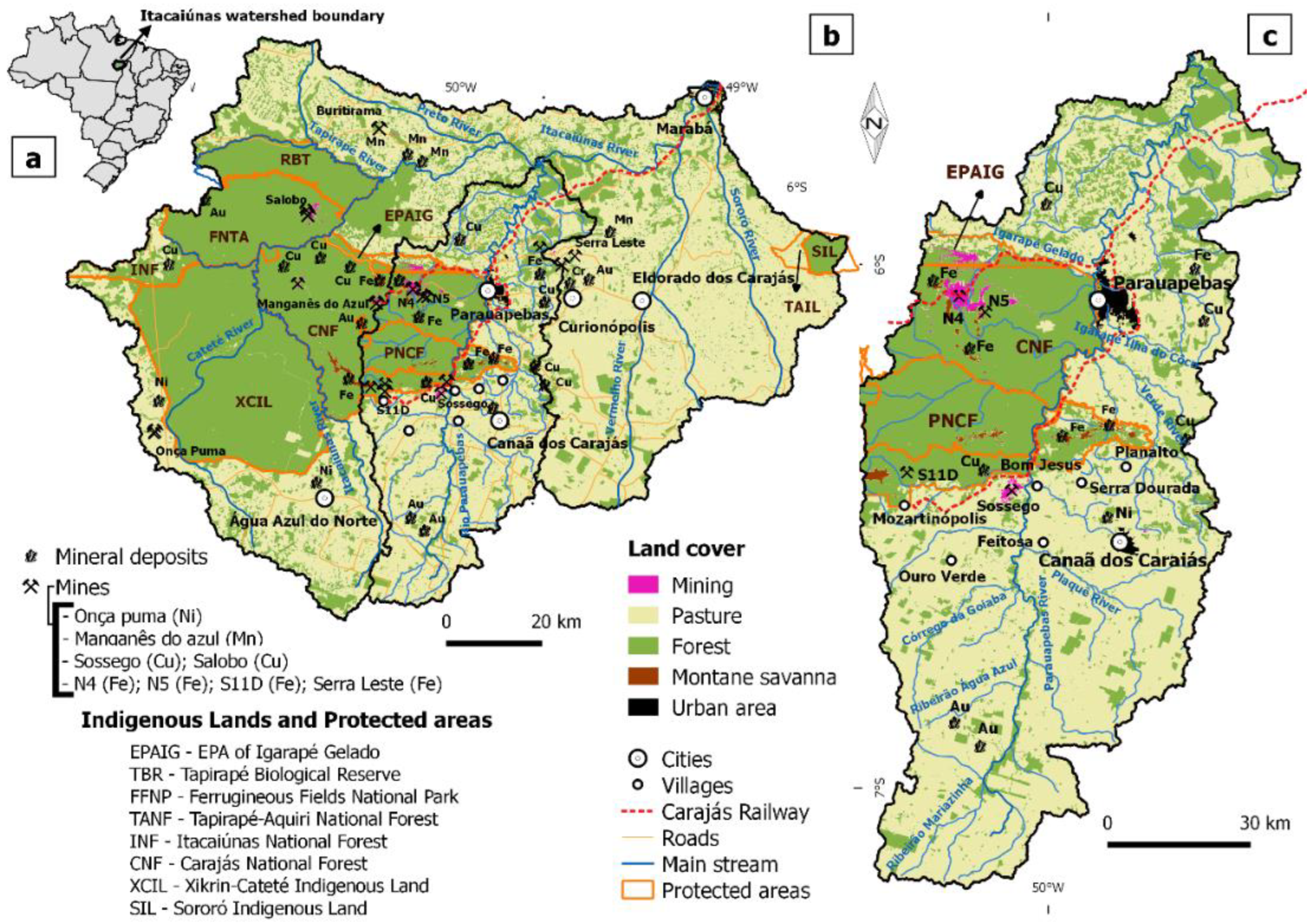
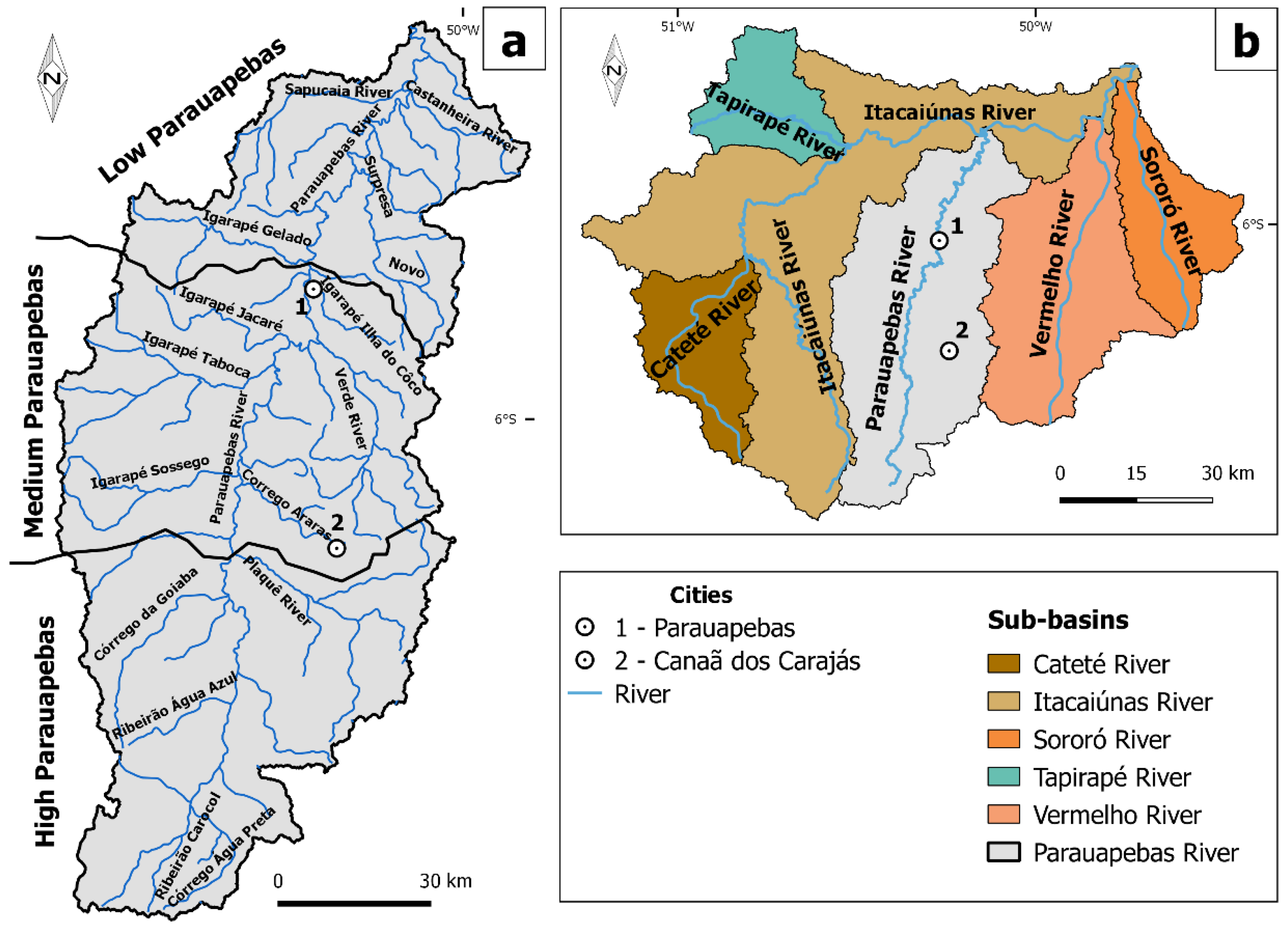

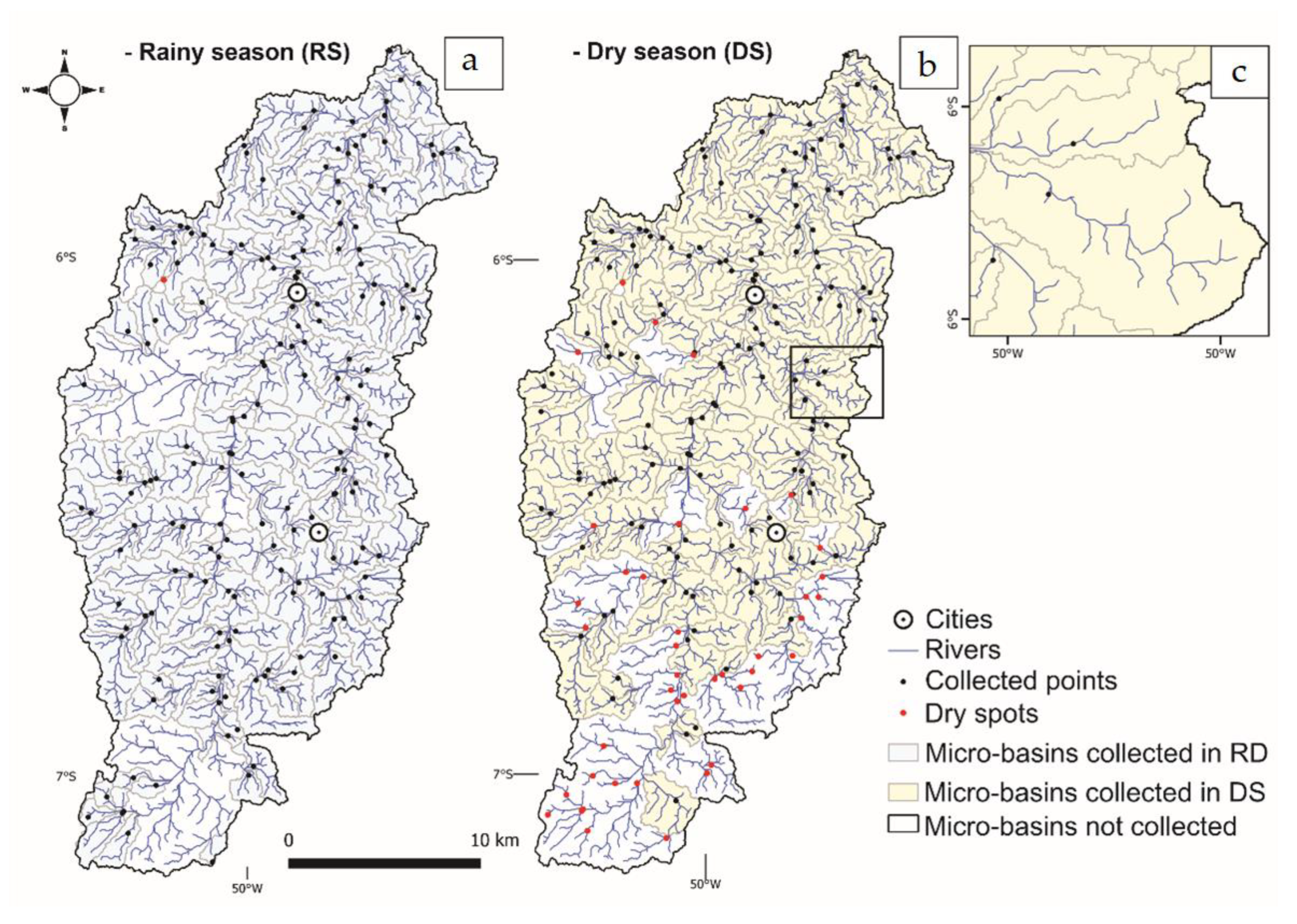

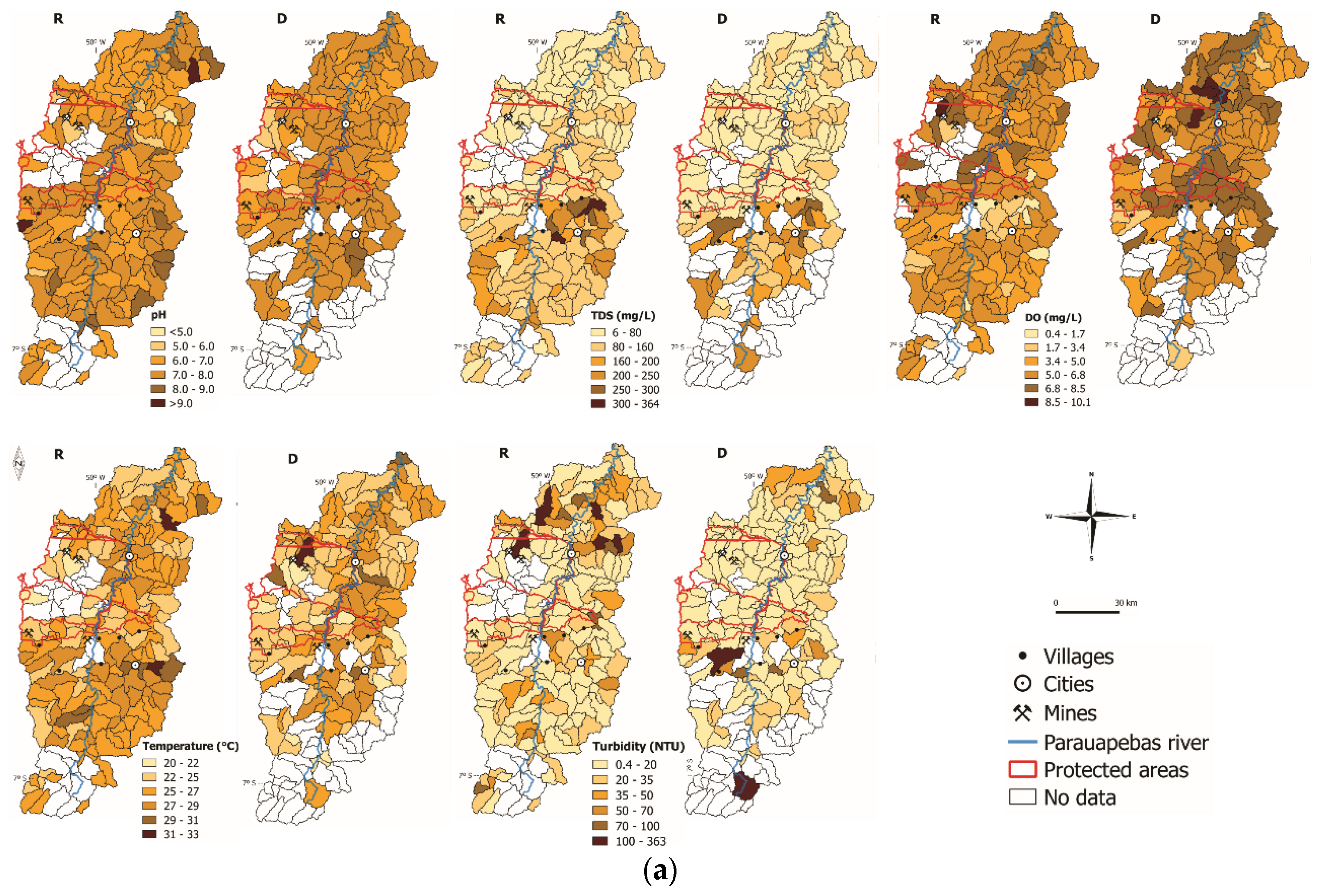
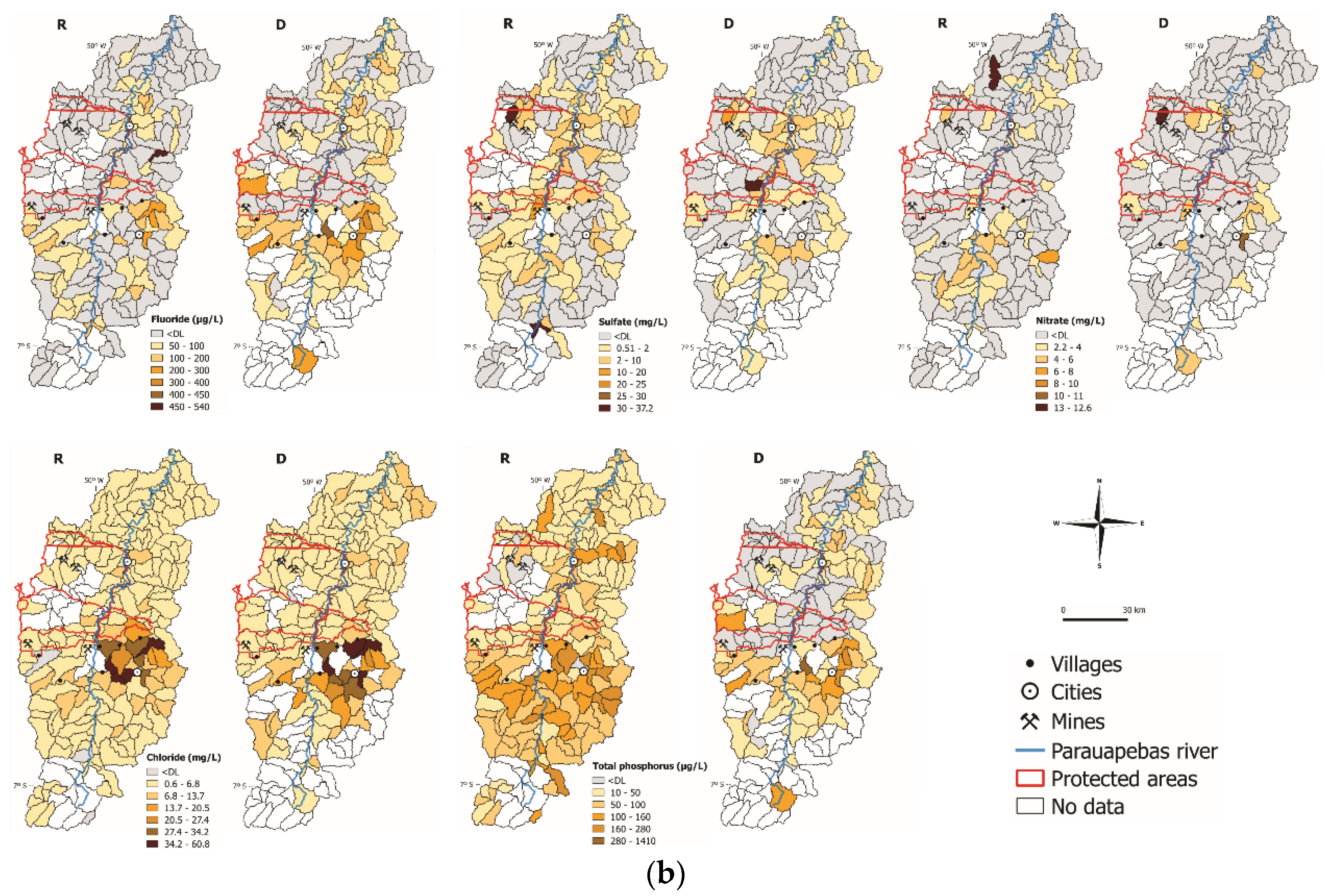
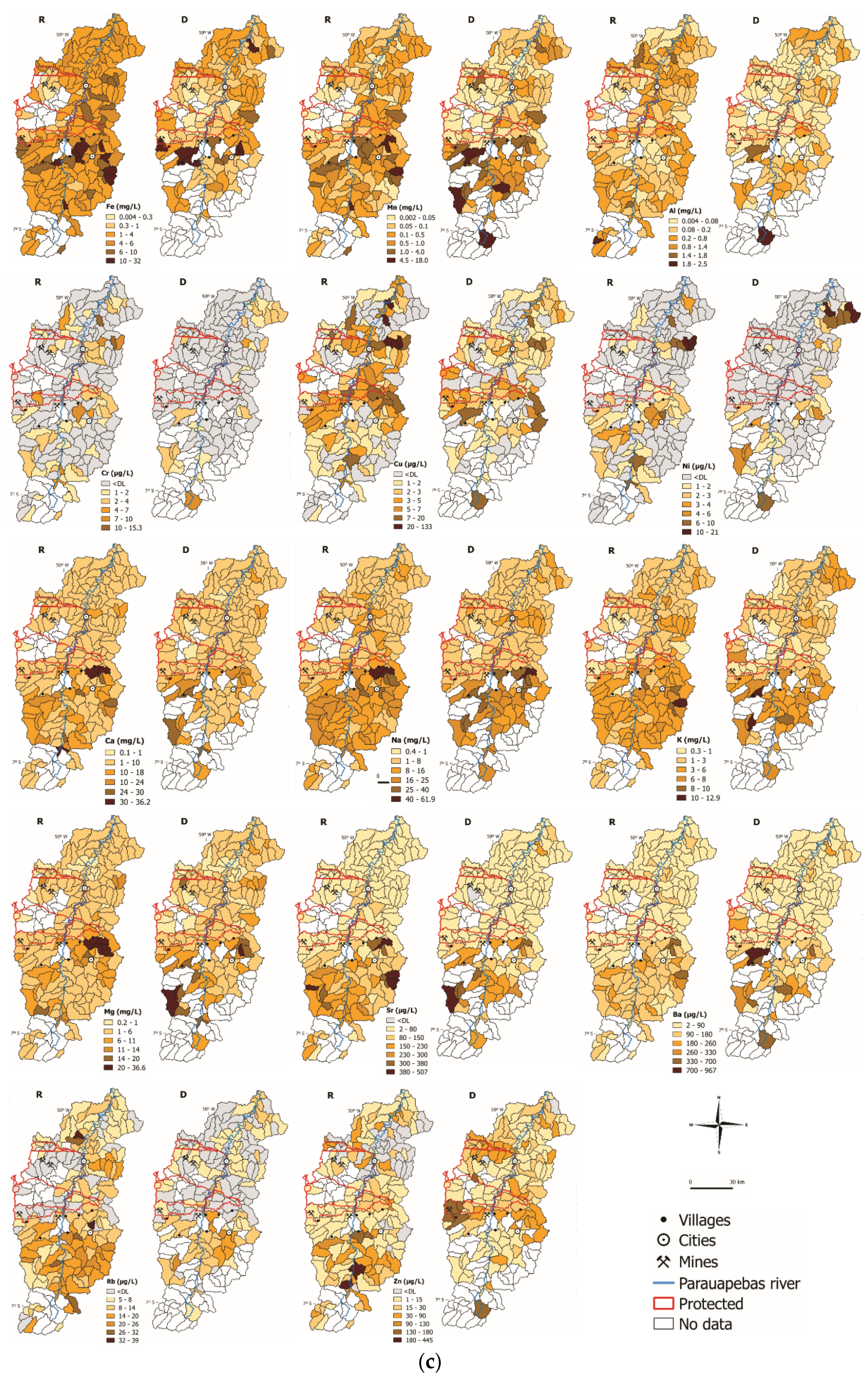
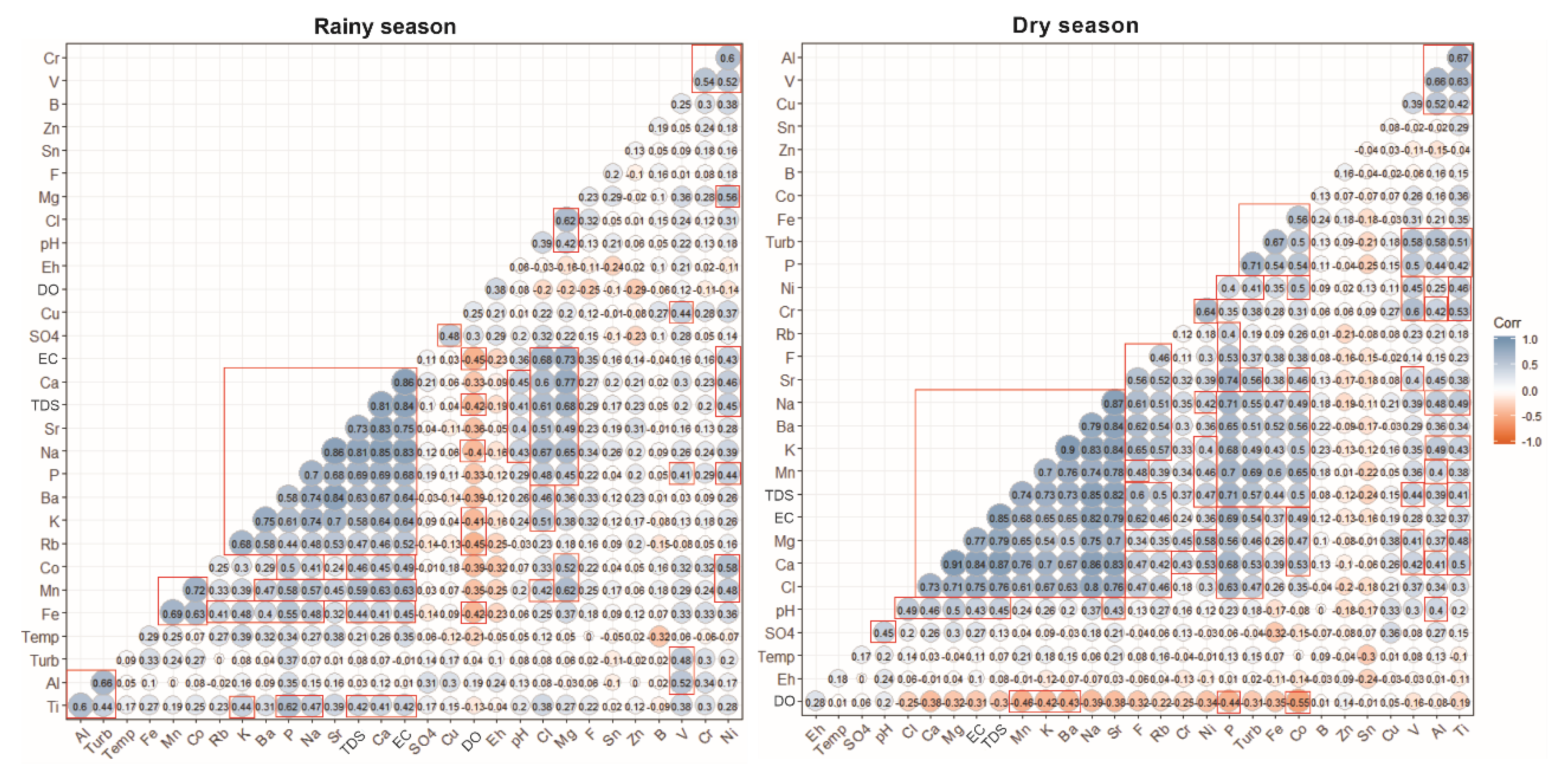
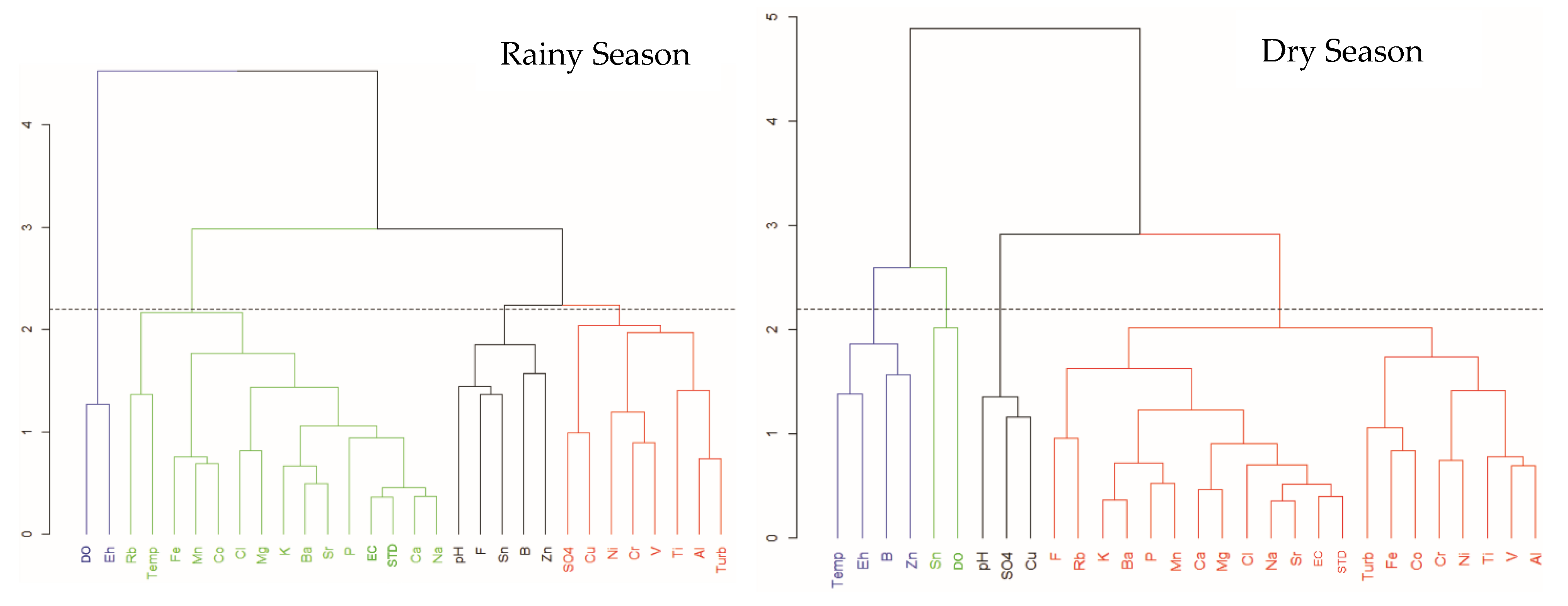
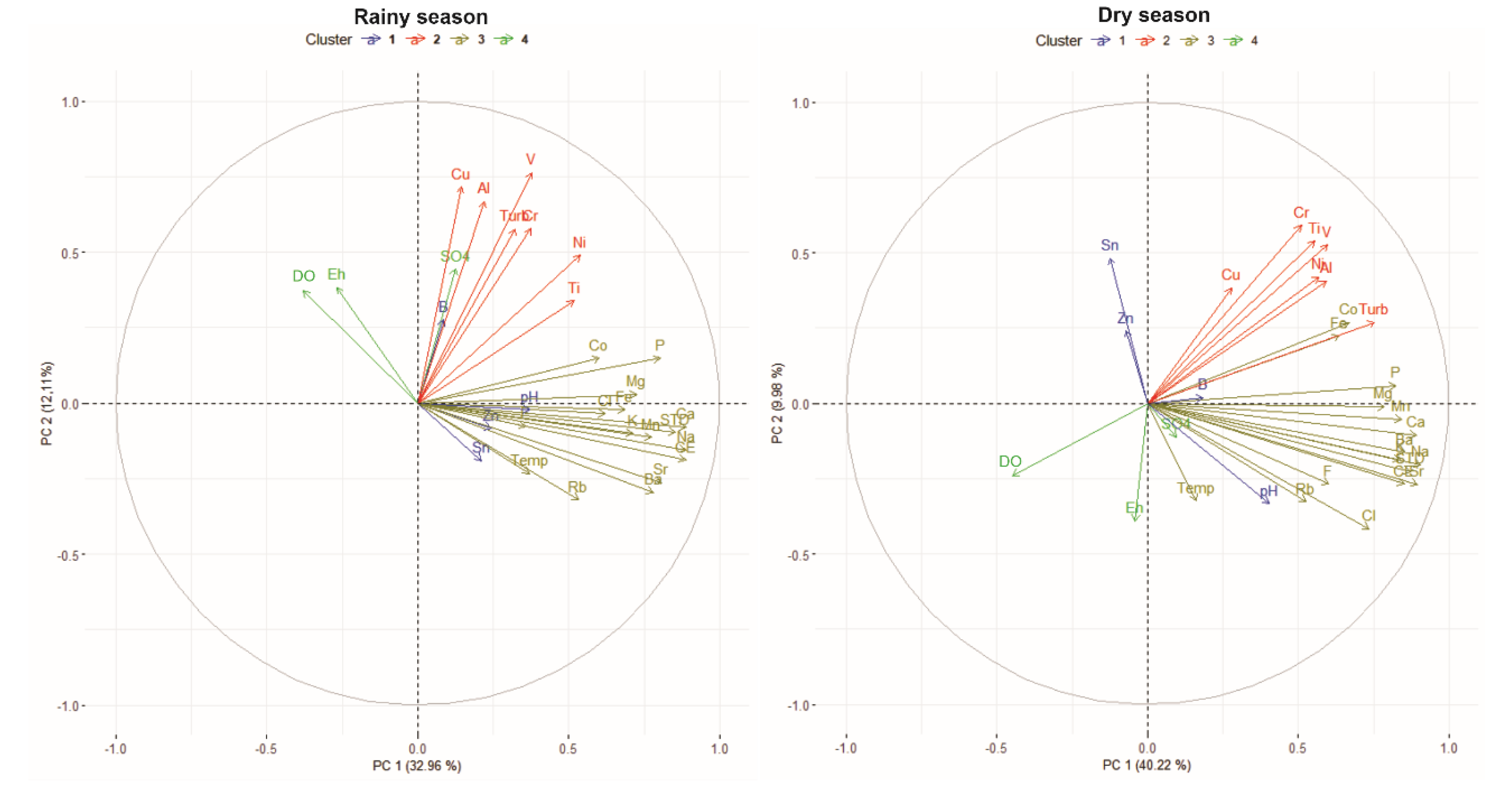

| Parameters | Unity | S | DL | Min | Max | A | Med | SD | CVar | Q1 | Q3 | |
|---|---|---|---|---|---|---|---|---|---|---|---|---|
| Physico-chemical parameters | DO | mg/L | R | 0.1 | 0.4 | 8.8 | 5.3 | 5.4 | 1.5 | 28.5 | 4.6 | 6.4 |
| D | 2 | 10.1 | 6.3 | 6.3 | 1.3 | 20.9 | 5.4 | 7.2 | ||||
| pH | - | R | - | 4.4 | 9.4 | 7.1 | 7.2 | 0.7 | 10 | 6.7 | 7.6 | |
| D | 5.2 | 8.3 | 7.2 | 7.2 | 0.6 | 7.8 | 6.9 | 7.6 | ||||
| Temperature | °C | R | - | 21.6 | 31.4 | 26.1 | 26.1 | 1.8 | 7 | 24.9 | 27.1 | |
| D | 20.1 | 32.5 | 25.3 | 25.1 | 2.3 | 9.2 | 24 | 27.1 | ||||
| EC | μS/cm | R | 1 | 14 | 534 | 116.6 | 94 | 91.8 | 78.8 | 53 | 149 | |
| D | 13 | 357 | 89.1 | 50 | 80.7 | 90.7 | 32 | 117.8 | ||||
| Eh | mV | R | - | 79.9 | 596.3 | 349.8 | 343.2 | 101.7 | 29.1 | 285.6 | 402.8 | |
| D | 208.6 | 605.8 | 354.3 | 368.5 | 81.2 | 22.9 | 295.5 | 405 | ||||
| TDS | mg/L | R | 5 | 6 | 364 | 106.1 | 94 | 65.5 | 61.8 | 62 | 133 | |
| D | 7 | 291 | 88.8 | 67 | 66.2 | 74.6 | 44 | 115.5 | ||||
| Turbidity | NTU | R | 0.1 | 2.4 | 363 | 29.1 | 20.1 | 39.5 | 135.6 | 12.3 | 31.5 | |
| D | 0.4 | 361 | 19.3 | 11.6 | 35.3 | 183.1 | 5.9 | 19.9 | ||||
| Anions and Ptotal | SO42− | mg/L | R | 0.5 | <0.5 | 32.9 | 1.4 | <0.5 | 3.7 | 268.3 | <0.5 | 1.3 |
| D | <0.5 | 37.3 | 1.2 | <0.5 | 3.4 | 290 | <0.5 | 1 | ||||
| F− | μg/L | R | 50 | <50 | 540 | 50.3 | <50 | 58.6 | 116.5 | <50 | 60 | |
| D | <50 | 430 | 75.2 | <50 | 71.3 | 94.9 | <50 | 100 | ||||
| Cl− | mg/L | R | 0.5 | <0.5 | 58.9 | 6.1 | 4.2 | 7.7 | 125.6 | 2.3 | 6.4 | |
| D | <0.5 | 60.8 | 7.4 | 4.6 | 10 | 135.3 | 2.4 | 7.7 | ||||
| Ptotal | μg/L | R | 10 | <10 | 270 | 71.7 | 60 | 58.1 | 80.9 | 30 | 100 | |
| D | <10 | 1410 | 55.2 | 20 | 136.9 | 248.1 | <10 | 50 | ||||
| NO3− | mg/L | R | 2.2 | <2.2 | 12.6 | 1.7 | <2.2 | 1.4 | 82.2 | <2.2 | <2.2 | |
| D | <2.2 | 12 | 1.6 | <2.2 | 1.5 | 93 | <2.2 | <2.2 | ||||
| Major components (cations) | Fe | mg/L | R | 0.02 | 0.06 | 22.4 | 3.6 | 2.5 | 3.2 | 91.2 | 1.74 | 4.3 |
| D | 0.04 | 32.3 | 2.1 | 1.0 | 3.7 | 174.5 | 0.5 | 2.0 | ||||
| Mn | mg/L | R | 0.001 | 0.006 | 18 | 0.51 | 0.14 | 1.6 | 318.9 | 0.08 | 0.3 | |
| D | 0.0019 | 7.2 | 0.5 | 0.08 | 1.0 | 217.6 | 0.05 | 0.3 | ||||
| Al | mg/L | R | 0.001 | 0.0194 | 2.5 | 0.3 | 0.2 | 0.3 | 119.9 | 0.09 | 0.32 | |
| D | 0.0049 | 2.3 | 0.14 | 0.07 | 0.26 | 183.6 | 0.04 | 0.13 | ||||
| Ca | mg/L | R | 0.001 | 0.9 | 36.2 | 8.0 | 6.7 | 6.2 | 76.9 | 4.1 | 9.7 | |
| D | 0.2 | 28.2 | 6.2 | 4.0 | 5.8 | 93.4 | 2.3 | 8.2 | ||||
| Mg | mg/L | R | 0.001 | 0.4 | 34.5 | 4.6 | 3.0 | 4.7 | 103.6 | 2.1 | 5.4 | |
| D | 0.2 | 36.6 | 4.9 | 3.1 | 5.4 | 109.3 | 1.8 | 5.5 | ||||
| K | mg/L | R | 0.001 | 0.3 | 11 | 3.1 | 2.8 | 1.8 | 59.3 | 1.8 | 4.1 | |
| D | 0.03 | 12.9 | 2.7 | 2.0 | 2.3 | 84.1 | 1.0 | 3.7 | ||||
| Na | mg/L | R | 0.001 | 1.1 | 61.9 | 9.4 | 7.2 | 8.8 | 93.5 | 4 | 11.1 | |
| D | 0.4 | 47.5 | 9.2 | 5.5 | 9.0 | 97.9 | 2.9 | 12.5 | ||||
| Trace elements | Ba | μg/L | R | 1 | 13.3 | 412 | 91.3 | 71.5 | 67.2 | 73.6 | 50.4 | 106 |
| D | 2.2 | 967 | 88.7 | 49.85 | 110.6 | 124.6 | 30.8 | 103.3 | ||||
| B | μg/L | R | 1 | <1 | 34.8 | 3.5 | 1.14 | 5.1 | 145.5 | <1 | 4.8 | |
| D | <1 | 15.4 | 2.5 | <1 | 3.0 | 122.2 | <1 | 3.6 | ||||
| Cu | μg/L | R | 1 | <1 | 133 | 3.9 | 1.73 | 11.1 | 282.3 | <1 | 3.7 | |
| D | <1 | 14.6 | 2.1 | 1.55 | 2.1 | 100.3 | <1 | 2.7 | ||||
| Cr | μg/L | R | 1 | <1 | 15.3 | 1.3 | <1 | 1.9 | 150.3 | <1 | 1.4 | |
| D | <1 | 7.01 | 0.9 | <1 | 1.0 | 110.8 | <1 | <1 | ||||
| Ni | μg/L | R | 1 | <1 | 21 | 1.4 | <1 | 2.2 | 157.9 | <1 | 1.7 | |
| D | <1 | 12.5 | 1.3 | <1 | 1.9 | 154.2 | <1 | 1.1 | ||||
| V | μg/L | R | 1 | <1 | 14.3 | 1.5 | 1.05 | 1.9 | 123.3 | <1 | 1.8 | |
| D | <1 | 15 | 1.3 | <1 | 1.8 | 139.4 | <1 | 1.4 | ||||
| Zn | μg/L | R | 1 | <1 | 445 | 20.3 | 8.4 | 48.0 | 236.8 | 2.0 | 23.2 | |
| D | <1 | 154 | 22.4 | 11.85 | 29.4 | 131.3 | 5.7 | 29.0 | ||||
| Sn | μg/L | R | 1 | <1 | 15.2 | 2.1 | 1.05 | 2.6 | 122.5 | <1 | 2.9 | |
| D | <1 | 17.5 | 2.4 | 1.7 | 2.7 | 114.3 | 1.04 | 2.5 | ||||
| Co | μg/L | R | 1 | <1 | 33.8 | 1.8 | <1 | 3.4 | 187.4 | <1 | 1.8 | |
| D | <1 | 29.9 | 1.5 | <1 | 3.1 | 205.6 | <1 | 1.2 | ||||
| Sr | μg/L | R | 1 | 5.6 | 507 | 89.8 | 57.5 | 96.2 | 107.2 | 20.2 | 126 | |
| D | <1 | 381 | 62.9 | 27.7 | 82.9 | 131.8 | 13.5 | 71.3 | ||||
| Rb | μg/L | R | 1 | <1 | 39.4 | 9.6 | 7.7 | 8.0 | 83.2 | 5.1 | 13.6 | |
| D | <1 | 21.3 | 5.0 | 5.2 | 5.1 | 101.4 | <1 | 8.2 | ||||
| Ti | μg/L | R | 1 | <1 | 62.8 | 8.9 | 5.6 | 9.1 | 102.0 | 3.2 | 12 | |
| D | <1 | 28.1 | 4.6 | 3.35 | 4.1 | 90.4 | 2.1 | 5.4 |
| Element | Unit | %<DL | CV (%) | CF | P75 | I2σ | DF | M_MAD | P95 | P98 | TIF | MPV |
|---|---|---|---|---|---|---|---|---|---|---|---|---|
| Ba_R | µg/L | 0 | 73.6 | 104.0 | 106.0 | 106.2 | 125.9 | 204.2 | 235.3 | 308.3 | 323.6 | 700 * |
| Ba_D | 0 | 124.6 | 96.0 | 101.8 | 64.8 | 94.6 | 316.2 | 256.8 | 394.5 | 595.7 | ||
| Fe_R | mg/L | 0 | 91.2 | 3.7 | 4.2 | 3.2 | 4.5 | 7.8 | 9.7 | 14.2 | 15.5 | 0.3 ** |
| Fe_D | 0 | 174.5 | 3.5 | 2.0 | 1.3 | 2.0 | 6.9 | 9.7 | 13.0 | 14.3 | ||
| Mn_R | mg/L | 0 | 318.9 | 0.4 | 0.3 | 0.2 | 0.3 | 1.0 | 1.7 | 3.4 | 1.9 | 0.1 * |
| Mn_D | 0 | 217.6 | 0.3 | 0.3 | 0.1 | 0.2 | 0.7 | 2.6 | 4.1 | 6.5 | ||
| Al_R | mg/L | 0 | 119.9 | 0.26 | 0.3 | 0.2 | 0.4 | 1.0 | 0.7 | 1.4 | 1.8 | 0.2 ** |
| Al_D | 0 | 183.6 | 0.13 | 0.1 | 0.1 | 0.15 | 0.4 | 0.4 | 0.7 | 0.8 | ||
| Sr_R | µg/L | 0 | 107.2 | 96.6 | 125.5 | 98.2 | 130.6 | - | 299.6 | 378.4 | - | NP |
| Sr_D | 0.7 | 131.8 | 25.0 | 71.0 | 34.4 | 59.9 | 275.4 | 248.2 | 310.8 | - | ||
| Ti_R | µg/L | 5.1 | 102.0 | 8.8 | 11.8 | 7.5 | 11.5 | 38.9 | 25.3 | 29.5 | - | NP |
| Ti_D | 6.5 | 90.4 | 5.7 | 5.4 | 5.3 | 6.5 | 13.5 | 11.8 | 15.2 | 21.38 | ||
| Zn_R | µg/L | 21 | 236.8 | 20.0 | 22.8 | 4.1 | 20.5 | 218.8 | 52.9 | 127.8 | - | 180 * |
| Zn_D | 2 | 131.3 | 9.0 | 28.9 | 10.7 | 25.9 | 134.9 | 56.8 | 150.7 | - | ||
| Rb_R | µg/L | 23.3 | 83.2 | 13.1 | 13.6 | 13.7 | 15.4 | 38.9 | 24.4 | 28.1 | - | NP |
| Rb_D | 47.7 | 101.4 | 7.7 | 7.9 | - | - | - | 14.6 | 16.5 | - | ||
| Cu_PC | µg/L | 32.4 | 282.3 | 4.3 | 3.7 | 2.2 | 3.9 | 28.84 | 10.9 | 28.5 | 75.0 | 2000 ** |
| Cu_PE | 24.8 | 100.3 | 4.1 | 2.7 | 2.9 | 3.2 | 8.13 | 7.1 | 9.6 | - | ||
| V_R | µg/L | 47.2 | 123.3 | 2.0 | 1.8 | - | - | 9.55 | 4.5 | 6.6 | 12.6 | 100 * |
| V_D | 58.2 | 149.4 | 1.8 | 1.4 | - | - | - | 4.2 | 6.8 | 7.1 | ||
| B_R | µg/L | 48.3 | 145.5 | 5.0 | 4.8 | - | - | 13.18 | 12.5 | 15.4 | - | 500 * |
| B_D | 52.3 | 122.2 | 6.4 | 3.5 | - | - | - | 9.1 | 11.8 | - | ||
| Sn_R | µg/L | 48.9 | 122.5 | 3.3 | 2.9 | - | - | 9.55 | 6.7 | 11.5 | - | NP |
| Sn_D | 24.2 | 114.3 | 4.6 | 2.5 | 2.9 | 3.5 | 5.50 | 7.0 | 12.4 | 9.0 | ||
| Co_R | µg/L | 56.8 | 187.4 | 3.1 | 1.8 | - | - | - | 6.1 | 10.2 | 11.9 | 50 * |
| Co_D | 68 | 205.6 | 1.3 | 1.2 | - | - | - | 5.4 | 11.0 | 4.7 | ||
| Cr_R | µg/L | 64.2 | 150.3 | 1.5 | 1.4 | - | - | - | 4.1 | 9.0 | 6.3 | 50 * |
| Cr_D | 78.4 | 110.8 | 4.0 | - | - | - | - | 3.2 | 3.8 | - | ||
| Ni_R | µg/L | 64.2 | 157.9 | 2.9 | 1.7 | - | - | - | 4.3 | 7.7 | 10.0 | 250 * |
| Ni_D | 73.2 | 154.2 | 2.7 | 1.1 | - | - | - | 5.0 | 7.9 | 3.5 |
Publisher’s Note: MDPI stays neutral with regard to jurisdictional claims in published maps and institutional affiliations. |
© 2022 by the authors. Licensee MDPI, Basel, Switzerland. This article is an open access article distributed under the terms and conditions of the Creative Commons Attribution (CC BY) license (https://creativecommons.org/licenses/by/4.0/).
Share and Cite
Quaresma, L.S.; Silva, G.d.S.e.; Sahoo, P.K.; Salomão, G.N.; Dall’Agnol, R. Source Apportionment of Chemical Elements and Their Geochemical Baseline Values in Surface Water of the Parauapebas River Basin, Southeast Amazon, Brazil. Minerals 2022, 12, 1579. https://doi.org/10.3390/min12121579
Quaresma LS, Silva GdSe, Sahoo PK, Salomão GN, Dall’Agnol R. Source Apportionment of Chemical Elements and Their Geochemical Baseline Values in Surface Water of the Parauapebas River Basin, Southeast Amazon, Brazil. Minerals. 2022; 12(12):1579. https://doi.org/10.3390/min12121579
Chicago/Turabian StyleQuaresma, Leandro Silva, Gessica da Silva e Silva, Prafulla Kumar Sahoo, Gabriel Negreiros Salomão, and Roberto Dall’Agnol. 2022. "Source Apportionment of Chemical Elements and Their Geochemical Baseline Values in Surface Water of the Parauapebas River Basin, Southeast Amazon, Brazil" Minerals 12, no. 12: 1579. https://doi.org/10.3390/min12121579
APA StyleQuaresma, L. S., Silva, G. d. S. e., Sahoo, P. K., Salomão, G. N., & Dall’Agnol, R. (2022). Source Apportionment of Chemical Elements and Their Geochemical Baseline Values in Surface Water of the Parauapebas River Basin, Southeast Amazon, Brazil. Minerals, 12(12), 1579. https://doi.org/10.3390/min12121579








